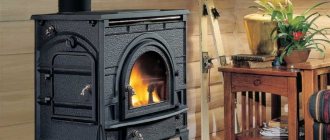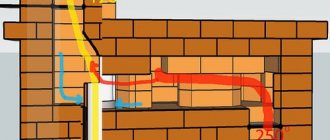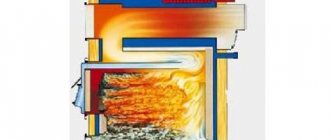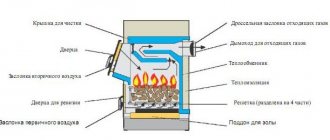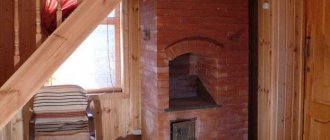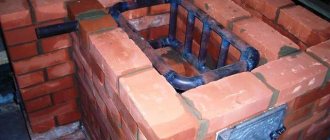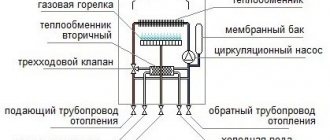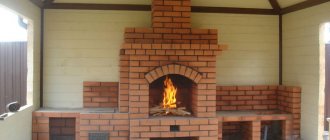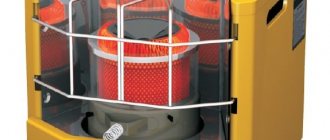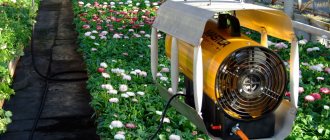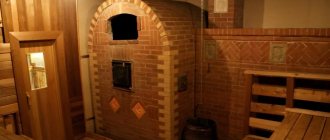Having a country house, you need to think carefully about the heating system. The best option would be a stove, which allows you to heat the building in the cold season and not spend money on heating structures that operate constantly. This is true if the family comes out of town only for the weekend. Let's look at how to make the right choice in detail.
Stove for a summer residence - selection criteria
The market for modern heating units is quite large, especially when it comes to real estate outside the city for temporary and permanent residence. Each type has its own positive characteristics, allowing each consumer to choose the optimal device.
At the moment there are traditional models:
- rectangular;
- round;
- square.
So are the modern ones:
- T-shaped;
- triangular;
- combined.
Before making a choice, it is important to consider the area and layout of the heated room. Most often, for a small country house, one stove is enough to quickly heat the space. It is better to choose a combined stove-fireplace that allows you to heat and cook food - this is beneficial in terms of organizing space.
Pellet stoves
Pellets are pellets made from wood waste ready for combustion, which is why such structures are also called granular. Even if the house has central heating, a pellet stove can be used as a backup, alternative or additional heat source. There are such types of ovens:
- convection, heating only the air inside the room;
- water contour and encircling “water jacket”;
- mixed type, running on different fuels (coal briquettes, firewood, wood chips);
- The power of pellet stoves is usually in the range of 15 kW - 1 mW, sometimes this figure can reach 3 mW.
A pellet stove can generate additional heat by burning gas released from burned pellets.
Convection models have special channels (empty cavities) located around the perimeter of the combustion chamber. The heated air is taken from below and, having warmed up in the cavities, naturally rises to the top, from where it is distributed throughout the room with the help of fans.
In addition, pellet stoves can be equipped with upper heating tanks, as well as devices for:
- forced air injection
- smoke removal
- dosed screw feed of pellets from the hopper
- automatic ignition
- adjustable output power.
Thanks to the latest developments, heat generation is carried out through constantly operating retort burners. This allows you to increase the autonomy of the pellet stove-fireplace to a significant level - more than a day in the residual combustion mode. The duration of heat transfer will depend on the capacity of the bunker.
An electronic control system programmed from a sensor unit can be built into the design of a pellet stove.
Features of fireplace stoves
This is the optimal solution for a small suburban cottage in which it is impossible to install a full-fledged heater. You can create a fireplace stove yourself, choose it in a store, or invite a specialist. An advantage is the fact that they can be heated with several types of fuel:
- firewood;
- coal briquettes;
- peat;
- coal.
They are safe thanks to special equipment - lining. The case heats up moderately, and heat is released over a long period of time. If finances allow, you can install a combination one, with additional drawers on top, for cooking.
In addition, fireplace stoves have the following advantages:
- ease of use;
- mobility;
- multifunctionality;
- not difficult installation.
But when assembling, it is necessary to take into account that it must be in a certain state from flammable objects (furniture, curtains, and so on).
Brick, cast iron, and thick steel are used for production. They have different designs, shapes and functionality. There are classic ones, but you can customize an ultra-modern model. The facade is decorated with the following elements:
- smooth walls;
- rectangular or square door;
- oven;
- top shelf for various items;
- external chimney, it gives a special appeal.
Economical wood-burning stoves and fireplaces are especially popular among consumers.
Which oven should you choose?
When choosing, it is important to consider several main factors:
- room heating rate;
- level of heat capacity of materials;
- type and availability of fuel for your area;
- heating unit power;
- fire safety level;
- all these features must correspond to the combination of price and quality of products from manufacturers of sauna stoves.
Heating stove manufacturers
The market offers products from various domestic and foreign manufacturers. But of course you can find a lot of counterfeits of well-known brands. Therefore, be sure to check the quality of workmanship, paintwork and all documents for the heating unit.
Leading manufacturers:
- Among domestic products, one can highlight Termofor products. But many fakes have appeared with untreated and uncleaned surfaces, so carefully inspect all the parts of the stoves;
- Among foreign ones, we will highlight Finnish manufacturers who have been working in our market for a long time and are known for their quality and good characteristics. Among them we highlight , “Kota”, “Castor”. The equipment is made from high-quality cast iron and heat-resistant or stainless steel. The high price does not allow them to occupy a leading position in our market, but at the slightest opportunity it is better to purchase expensive, but high-quality and durable equipment.
Best models
The best heating stoves for the home are presented in our Top 10 (various options are presented from conventional heaters to stoves).
| Model | Characteristics | Average price in rubles |
| Electric heater “Ballu BHH/M-09” | The device is equipped with a halogen radiating element. Possibility of operation in 2 modes - 0.45 kW and 0.9 kW. Weight 1.1 kg. Room area – 15 m2. | 600 |
| Electric heater model “NeoClima NQH-04” | Equipped with a protective shutdown system when the device is thrown over. 2 quartz heating elements. Weight from 1 kg. Its minimal dimensions allow it to be used in small rooms without the risk of fire. 2 operating modes. | From 650 |
| Model of electric heater for a country house “DELTA D-018” | The device is equipped with mechanical control of operation in 4 modes. Equipped with a fan and temperature sensor. Quartz heating element. Maximum power – 2 kW. It is possible to turn off one or more heater lamps if they are damaged. | From 1700 |
| Model "Matrix" running on solid fuel | Equipped with a convection system with an outer steel casing. The combustion time for a full load of firewood is 8 hours. The model can be equipped with a frying panel. A door made of heat-resistant glass is installed. The area of the premises in the garden house is up to 140 m2. | From 12000 |
| Budget option for a small country house “Cinderella” | Runs on solid fuel. A hob is installed. The small dimensions and cubic shape of the stove allow it to be installed even in small rooms, taking into account fire safety regulations. The door is made of heat-resistant glass and its design features make it easier to load firewood into the combustion chamber. | From 8000 |
| Model "Breneran" | A long-burning stove, with the time of complete combustion of 1 load of firewood up to 12 hours. The combustion rate of firewood is controlled by a slide valve. It is additionally equipped with a system of convection pipes in which cold air from the furnace wall is heated. | From 25000 |
| Heating stoves for home and garden with a built-in water tank and a built-in arched panel “L-08 CCE”. | The stove is expensive, but it allows you to install a water heating system in the house. Produced in Spanish. Material – cast iron. Dimensions (height, width, depth in mm.) 850/1000/635. 76% efficiency level. Power – 23 kW. Chimney diameter 150 mm, oven 440 mm. Weight 295 kg. | From 514000 |
| Gas heater, ceramic “Kovea KH-1203 CUPID HEATER” | Equipped with a piezo gas ignition system and a ceramic heating element. A safety valve is installed that is activated during surges and insufficient pressure levels. Made in a durable plastic case. Weight – 1.4 kg. Power 1.4 kW. | From 6920 |
| Model “Pathfinder Hearth PF-GHP-IM02” | Gas infrared heater. The power of 1.5 kW allows it to be used to heat a separate room or a small garden house. Equipped with a gas preheating system and piezo ignition. Can be connected to any type of gas cylinders. Weight 1.8 kg. Gas consumption 108 g for 1 hour of continuous operation. | From 2280 |
| . Gas stove – fireplace “OV-120” | Efficiency level is 78%. Runs on solid fuel. Frame structure, made of materials with average heat capacity. The chimney is connected from above, the diameter of the outlet pipe is 150 mm. Weight 70 kg. The volume of the heated room is up to 120 m3. | From 24600. |
Classic wood burning fireplace
This is a traditional heating device that is used in buildings of any size. The device not only heats the room, but also gives it a unique comfort in winter, when dry firewood crackles in the firebox, from which warmth emanates. There are several ways to install the device:
- wall;
- angular;
- island;
- built-in;
- with open or closed fire;
- rotating;
- with a swing door.
There are a wide variety of designs for products of this type:
- modern;
- high tech;
- classic;
- individual style.
By choosing a wood-burning stove, a person gets a durable and easy-to-use unit; it will enliven the design of the room and warm it with an open fire with the cheerful crackling of firewood.
Convection ovens - operating principle
Convection ovens can operate on almost any fuel. This can be firewood, coal, fuel oil, agricultural waste, pellets, briquettes and so on. It doesn’t matter what to heat such a stove with. It is important that during the combustion process, thanks to its design, it very quickly begins to warm up the room.
A conventional convection oven has holes in a special air jacket that surrounds the firebox, or has finned surfaces that quickly and intensely heat the air next to them. Hot air from the jacket or heat exchanger rises. It is immediately replaced by cold air, which is sucked into the shirts from below.
Thus, the movement of air masses occurs - convection. Powerful convection ovens from 10 kilowatts and above can not only create convection currents in their heat exchangers, but also effectively mix air masses indoors.
The more powerful the stove, the more it affects the rate of mixing of air masses indoors. This means that a 20 kW convection oven heats the room faster than the same one, but by 10-15 kW.
And even if a 10 kW oven is enough to heat your room, a powerful convection oven will warm up this room much faster.
Here an analogy with an air heating gun suggests itself. The more powerful the gun, the faster the room warms up, the greater the volume of air passed through the heat exchanger.
Gas fireplaces
These devices have a very different heating system, although outwardly they are the same as wood-burning devices. The concept is that inside the firebox there is a gas burner in a cast iron body, which is covered with tempered glass on top. This design is equipped with imitation coal or firewood, to make it more similar to the traditional version.
The advantages of such a unit for a summer residence are as follows:
- inexpensive fuel price;
- automation of all processes;
- complete security;
- maximum efficiency;
- minimal fuel consumption with good power;
- ergonomics and ease of installation.
The only disadvantages are its cost and the need to supply electricity, so you will have to turn to specialists, and repairs may not be cheap.
Gas ovens
A gas stove is suitable not only for a gasified dacha. If the dacha is used only in the warm season (say, where the basis of the economy is a garden or apiary), then the stove is needed only for cooking, and searching for solid fuel in the surrounding area or its delivery is no longer justified. The second option, when a gas stove turns out to be better, is to visit the dacha in winter, but only occasionally. Let's say, relaxing after a ski trip or ice fishing.
Gas stoves for summer cottages
For cooking for one person in places completely remote from the benefits of civilization, the optimal choice would be a Taganok stove, pp. 1-3 in Fig. Pos. 1 is a tourist/hunting mini, its refueling lasts for one or two days. For longer-term use (say, for a nomadic apiary), you need to take a Taganok with a cylinder of increased capacity (item 2), it lasts for a week or a month. Recently, an innovation has appeared on sale: a taganok with a reflective burner, pos. 3. Thermal radiation reflector on the cooking utensil allows you to save 15-20% of gas.
For regular picnics, it’s a good idea to get a universal gas barbecue grill, pos. 4. These, as a rule, are equipped with a branded cylinder of sufficiently large capacity, so it can be used to power both an ordinary compact gas stove (item 5) and a portable gas stove with oven, carried in the trunk of a car, item. 6.
A special article on gas heating and cooking appliances is furnaces and calorifiers for catalytic combustion of gas. They are quite expensive, but extremely economical. Their only drawback, which still prevents their widespread distribution, is the small limits of power adjustment, so kitchen models (item 7) are rarely found in everyday life, and instantaneous heaters, directional and non-directional (items 8-10), have to be selected accordingly required heating conditions.
Brick fireplace
Often, owners choose to install a brick product by making it themselves. It heats up very quickly and then releases heat into the space for a long time. Brick stoves come in the following types:
- semi-open, built into the wall or located along it;
- open – an excellent option for large areas;
- closed - it is carried out immediately during the construction of a country house;
- corner - help to heat 2 rooms.
For assembly you need to prepare the following material:
- brick: fireproof, ordinary, facing;
- valve;
- steel.
A brick fireplace is heavy, so it cannot be installed without a foundation. The base is located 10 cm below the floor level, and it must be reinforced with reinforcing mesh. After the poured solution has dried and gained its maximum strength, you need to install high-quality waterproofing using 2 layers of roofing material, on which a layout of two rows of masonry bricks is installed.
Further work is carried out according to the following algorithm:
- the first row is laid in such a way that the walls are strictly perpendicular to each other;
- on the next two, a niche for firewood is built, then it is covered with 2 brick ones with a small overlap on the side of 4 cm, on top of 2 cm;
- fifth - fireclay brick for arranging the hearth;
- as soon as the hearth is ready to form the vault, a steel sheet is laid and then the masonry continues with the arrangement of the chimney;
- having reached the 27th row, you need to install a valve on the side;
- after this, work continues until the pipe is brought to the roof;
- As soon as everything is finished, they begin to decorate the exterior and decorate it at their own discretion.
Brick kilns
Let's start looking at country stoves the old fashioned way, with brick ones. Whatever you say, a brick oven adds a special charm to both the dacha itself and outdoor recreation. All brick stoves, if the country house has several rooms, are of good quality: built into the wall, they can heat 2-4 rooms at a time.
Note: the last remark is only valid if the stove is included in the design of a new house. If a stove is being built in an existing house, its foundation should not have a mechanical connection with the foundation of the building, and the body of the stove should not have a mechanical connection with its walls. The reason is unequal shrinkage.
Russian
Russian stove
The Russian stove (see figure on the right) is a phenomenon of global significance not only in the stove business. Experts with academic degrees are still struggling with some of its secrets. And sleeping on a bed (and not just sleeping) when the frost is cracking outside the wall or pouring rain is lashing is an indescribable pleasure. And the gastronomic wonders of Russian cuisine are impossible without a Russian oven.
However, for an ordinary dacha, a Russian stove, despite all the sympathy for it, still cannot be recommended . It is bulky, complex, very expensive, does not tolerate downtime in the cold season, and shows all its advantages only with regular heating. And according to the technical requirements, it takes a very long time to heat, and can only heat one room. In the summer you can’t melt it in the room at all - you’ll bake it yourself; our ancestors built separate stoves outside for the summer. In general, a unique, but not at all country stove. Perhaps for a shady archaic who is ready to go to any expense for the sake of his, primordial, age-old.
Dutch
Dutch ovens
The Dutch oven belongs to the type of channel ovens, and therefore requires a qualified firebox: the viewer was closed at the wrong time, or the oven cooled down in vain, or fumes started. It may be suitable for a dacha due to its compactness: a purely heating unit can be made in the form of a column with a side of 2 bricks, i.e. 520x520 mm, on the left in Fig. With some extension, it allows you to build in a hob (on the right in the figure), but there is a problem with the water heater - like most channel stoves, the Dutch oven does not tolerate disruption of the internal heat circulation.
Another disadvantage for a dacha is that the fuel needs to be of sufficient quality; kurai and garden waste will burn in a Dutch oven, but they will produce a meager amount of heat and a lot of soot, and cleaning the Dutch oven, like all channel stoves, is difficult. Finally, like any brick oven, the Dutch oven takes a long time to warm up, so it is not suitable for quick heating after working in the cold. Of course, it also needs a foundation.
Arranging a compact Dutch oven
The undoubted advantages of the Dutch oven are its simplicity and relative, compared to other brick kilns, low cost. A Dutch oven can be built by a homemaker who has no experience as a stove maker, and no expensive refractories are required; ordinary red brick with clay mortar is sufficient. In Fig. on the left is the order of the Dutch column shown above, and on the next. rice. – Dutch oven with side stove and oven. A Dutch oven can heat up to 4 rooms at once.
Arrangement of a Dutch heating and cooking stove
Swede
The Swedish oven appeared in the second half of the 18th century, when science was already quite developed and the rational way of human thinking triumphed. Therefore, its efficiency is significantly higher than that of the Dutch (up to 65% versus 40-45%). The Swede was originally a channel-type heating and cooking stove, although later bell-type stoves appeared (see below), operating like a Swede.
The Swede has 3 design features: an oven next to the firebox, an obligatory hob in a niche, and above it there is a voluminous stove (actually, another niche) for drying. From the open door of the oven, immediately after lighting, heat radiates, which allows those who are chilled to quickly warm up. And in the same oven, you can build in a hot water heater for hot water without deteriorating the oven’s performance; The storage tank can be installed at the top of the furnace.
Classic Swedish ovens
The disadvantages of a Swedish stove for a summer residence are common to all brick stoves: it is quite bulky (on the left in the figure), a foundation is required, it must be heated skillfully, like a Dutch stove, and it is just as demanding on fuel. It is difficult to build a Swedish stove, so we do not provide instructions for beginners (especially since they can be found in a separate material about Swedish stoves), but good stove makers know them themselves. In country Swedes, for the sake of compactness, the oven is often turned 90 degrees, and the entire oven is turned the same 90 degrees in the opposite direction. If the dacha is inhabited only in the not very cold season in our area, where the air is generally drier than in Scandinavia, the oven of such a Swede is often turned into a fireplace (on the right in the figure), lined with fireproofing and making an exit into the chimney (then you need additional view), or by bringing the fireplace chimney up parallel to the stove, then you can immediately admire the fire and cook. You can heat 2-3 rooms at once with a Swedish stove.
About bell furnaces
Bell-type furnaces have a much higher efficiency than channel furnaces, they warm up faster, and they can accommodate so-called. gas view, which simplifies the use of the stove and makes it safe. But bell-type stoves are not suitable for dachas: their rather delicate design does not at all tolerate stopping the firebox during the cold season. If a Russian stove that has overwintered in an abandoned hut can still be revived with a special acceleration mode, then the bell-type stove after such a winter will crack from the slightest light in the firebox.
More about fireplaces
A fireplace in a country house is also good because it allows you to quickly warm up, which is required mostly more often than cooking. Based on this, an original design was born: not a fireplace stove, but a country fireplace stove, see fig. below. To light a fire in the fireplace, the damper is opened, the stove burners are closed with standard plugs, and the fire is lit directly on the stove. If used infrequently, this will not ruin it. For cooking, the damper is closed, the fire is lit in the firebox, and the flue gases escape into the chimney through a constantly open bypass channel. In fireplace mode, it ensures good afterburning and increased efficiency.
Fireplace stove
About brick barbecues
Barbecue made from construction waste
The category of brick ovens also includes barbecues with stationary grills. Their device is a subject for a separate discussion. Let us mention here that it is for such simple devices that invention, ingenuity and artistic taste are of particular importance. For an example, see Fig. barbecue made from construction waste. And it looks no worse than an expensive designer’s creation made from wild stone.
Potbelly stoves
You can go through many types for a country house, but the most optimal is still a potbelly stove. It is inexpensive, does not require a lot of fuel, and as for efficiency, if used correctly, it will not be inferior to all other units.
A potbelly stove is made of cast iron - a durable and strong material that will last for decades.
The main advantage of a potbelly stove is the ability to heat with all known types of fuel, only with gas it is not quite as efficient as with exhaust. In addition, this design can be used to make a long-burning unit with an air throttle in the blower. Pallets or simple sawdust are placed in the firebox, which burn almost all night and do not overheat the firebox.
How to choose?
To choose a quality device, you need to decide on your needs and pay attention to the option that best suits them.
For a summer residence, it is recommended to choose solutions that have a surface for heating food. For home use in small spaces, electric options are the best. They will be a mini oven with convection.
When purchasing, you should pay attention to such indicators as:
- power;
- dimensions;
- material of manufacture;
- presence of a hob;
- installation safety;
- fuel used.
Models for home
- Flames KP-2. This stove has small dimensions, its weight is only 44 kg and there is a 40 liter combustion chamber. It is suitable for use in cabins, because it helps to uniformly heat the room.
- Flames KP-4. This oven is slightly larger in size. It has a power of 4 kW, so it can be used for medium-sized rooms. It has a simple design and attractive appearance.
- Furnaces of Professor Butakov. This option is suitable for heating your own home. It can be installed in the basement. The design works with solid fuel and consumes very little of it.
- Teplodar Matrix 100. This design has the advantage of being compact. At the same time, it can quickly heat about 100 cubic meters of area. It has a glass heat-resistant door and a two-channel afterburning system.
- Heater 100. There are also smaller models, so you should choose the appropriate option based on your needs. This stove can heat up to 100 cubic meters. The body is made of hardened steel. Best suited for household use.
Which oven is better?
A heating device for a dacha is selected depending on certain conditions:
- if you don’t need a fireplace with a specific design and aesthetic appearance, it’s definitely a potbelly stove. It is advantageous in many ways than any other option;
- There is gas on the site, then it’s worth stopping at gas;
- If you decide to install a fireplace stove, then the best option would be to buy a firebox and then design it at your own discretion - it will be cheaper. If you don’t want to install a chimney, you can buy a biofuel heating device;
- It is better to install a Dutch or Swedish stove for a brick stove.
- But no matter what heater you choose, it must perform the following functions:
- parameters must withstand long periods of heating;
- it should melt as quickly as possible and quickly switch to high heat transfer mode;
- retain the accumulated heat for a long time so that it does not have to be heated at night;
- in order to save space, it is advisable to be able to install a hob on the stove;
- be economical and practical with maximum space savings;
- Fire safety is the basic rule.
You shouldn’t go for overly complicated stoves for your dacha - in this case you’ll have to call a stove maker out of town, and this is very expensive. It is important to think through the issue of heating a dacha building very carefully; how efficient it will be depends on this. But in any situation, the choice always remains with the owner of the country property.
For all questions related to selection, please contact our store specialists. Have a good day!
About purchased fireplaces
The generally accepted idea that a dacha without a fireplace is not a dacha is completely justified in any case. Already the separation of dreamy-contemplative functions from purely utilitarian ones makes it possible to greatly simplify the choice or construction of a stove. In this case, you need to think about a ready-made fireplace insert, of which the sea is now on sale. Such fireboxes are not very expensive; they run on either biofuel or any flammable waste. They are completely safe, to the point that they can be lined with dry firewood for decoration, or combined with a bookcase or bar. Design - for every taste, see fig. No permission is required.
Country fireplaces
